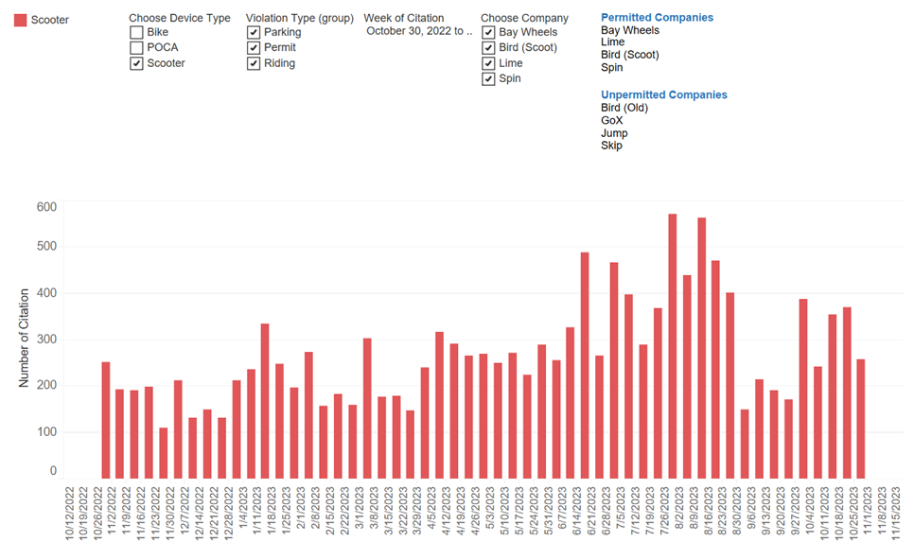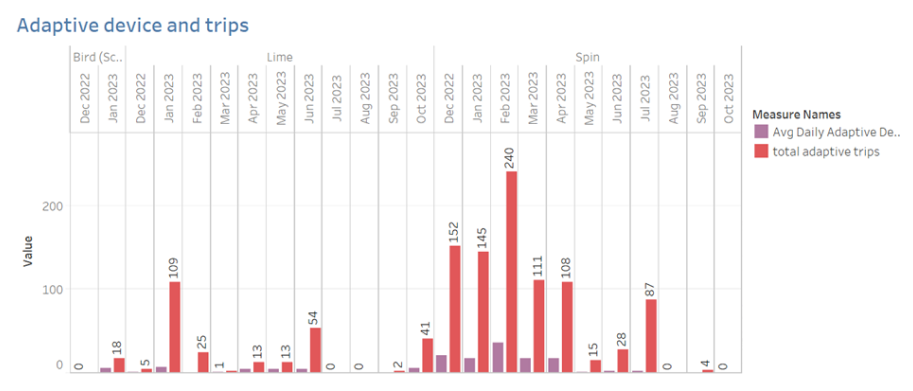Key Takeaway: In the last few years, the SFMTA has promoted accessible options for micromobility services like bikeshare and scooters. Adaptive cycling and scooter program ridership could provide more transportation options for people with disabilities.
Adaptive Bikeshare in Golden Gate Park
From 2019-2021, San Francisco piloted an adaptive bikeshare program in Golden Gate Park. Five types of adaptive bike were available during the pilot: an upright handcycle, a recumbent handcycle, a recumbent leg trike, a recumbent trike tandem and a side-by-side tandem. Bay Area Outreach and Recreation Program (BORP) staff were available to fit participants to adaptive bikes and help participants transfer from their mobility devices when necessary.
On average, adaptive bikeshare riders rated the program 4.76 out of 5 stars. In rider surveys, participants shared that the program was a good family outing and that it provided access to recreational opportunities they could not find elsewhere. However, awareness of the program was limited and therefore ridership was low, with 34 riders taking a total of 90 rides in 2021.
After the end of the program, the adaptive bikeshare pilot became a permanent adaptive cycling program through the San Francisco Recreation and Parks Department, the SFMTA, and the Bay Area Outreach and Recreation Program (BORP). Given the popularity of the program among existing riders, the city has an opportunity to serve more people with disabilities, but knowledge of the program must increase.
Adaptive Scooter Share
Starting in 2019, the SFMTA required scooter share companies to pilot adaptive devices and in 2021, the Powered Scooter Share Program permit required that adaptive scooters must be included as a permanent element of scooter share programs.
Adaptive scooters must have at least two of the following three attributes: a seat, a basket and three wheels. In the permit cycle that began in 2021, all permittees opted to offer adaptive devices with seats and baskets. The permittees also offer a wider range of adaptive devices through their Complementary Adaptive Programs. These devices can be rented for longer periods of time and are scheduled for drop-off and pick-up at a location of the rider’s choosing.
Scooter permittees are required to deploy adaptive scooters on city streets, making up a minimum of 5% of their total fleet, although scooter companies have not always met this requirement. Some months of the scooter program, we are seeing hundreds of adaptive rides, and others just a handful.
Scooters on Sidewalks
The SFMTA has worked with scooter share companies to decrease the number of incorrectly parked scooters and illegal scooter riding on sidewalks.
Scooters should be parked in the furnishing zone of sidewalks and locked to a bike rack, but they are sometimes left in the path of travel, causing obstructions and tripping hazards for people with disabilities. The SFMTA collaborated with the San Francisco Mayor's Office on Disability to establish scooter parking requirements that, if followed, provide an accessible path of travel.
Scooter companies are responsible for educating riders on the requirements and can be fined for scooters blocking the path of travel. Our enforcement team deploys on-street staff to issue citations for improperly parked devices.
In April 2023, the SFMTA implemented the Safe Micromobility Parking Incentive Policy. Since then, scooter company response time to move improperly parked devices has decreased from an average of 6-plus hours to less than 45 minutes on average. We are also installing more parking for scooters and bikes on-street, off the sidewalk, with more bike corrals.
Sidewalk riding is illegal and a hazard for all pedestrians. Disabled pedestrians and older adults have expressed particular concern about scooter riding on the sidewalk. The SFMTA amended the Transportation Code to require all permitted scooters to be equipped with sidewalk detection technology and permittees to submit monthly reports on sidewalk riding.
The SFMTA does not have the authority to officially cite people illegally riding on the sidewalk. Only the SFPD can do that. However, we are engaged in ongoing safety education campaigns to encourage better behavior. Last year, we kicked off a scooter safety education campaign with posters and ads on buses, transit stops and social media. This year, we expanded the campaign with new videos and social media content.
In 2023, the SFMTA worked with outside consultants to evaluate the agency’s Powered Scooter Share Permit Program. The findings will help inform the future of the scooter program in San Francisco.
Active Transportation Days for Seniors and People with Disabilities
The SFMTA has also been encouraging active transportation for seniors and people with disabilities through our Adaptive Transportation Days.
Since 2021, the SFMTA and San Francisco Recreation and Park have co-hosted the Active Transportation Days in Golden Gate Park. The events enable people to try adaptive cycles and adaptive scooters in a safe, welcoming environment. Along with adaptive cycles provided by the Bay Area Outreach and Recreation Program, scooter share companies provide a range of adaptive scooters for riders to test out and provide feedback on.
The SFMTA has also partnered with specific organizations on adaptive scooter demonstrations, coordinating annual events with the Access SFUSD program, which serves students with disabilities ages 18-22.
In September 2023, the Accessible Services Section made a renewed commitment to hosting an annual Accessible Transportation Day for the community to learn about and try adaptive micromobility options in a safe and welcoming environment.
Future Opportunities
Looking forward, incorporating adaptive bikes and micromobility options in regular active transportation planning and new projects can help increase adoption and ridership. Programs and projects such as mobility hubs, Slow Streets and bicycle and scooter education programs are all opportunities to attract riders of all abilities.
Figure 1. Adaptive Scooter Average Daily Ridership and Total Trips (12/2022-10/2023)
Figure 2. Scooter Citations (10/2023 – 11/2023)

